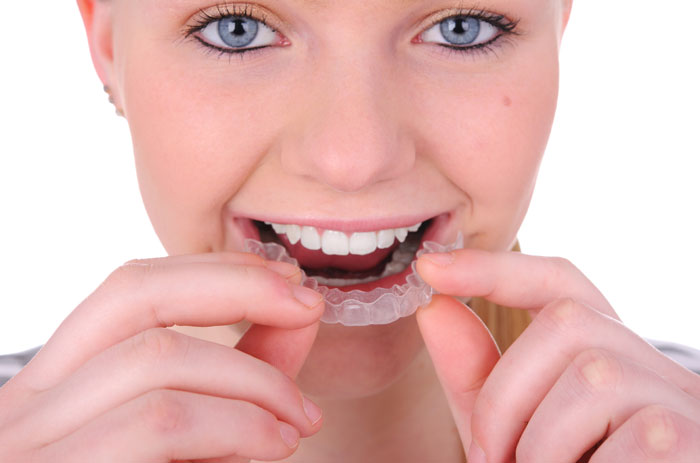How Does Invisalign Move My Teeth?

If you’re unhappy with the appearance of your teeth and are thinking about joining the five million people worldwide who have opted for Invisalign, you may well be asking yourself: “How does Invisalign move my teeth?”
Although Invisalign aligners are far more discreet than traditional braces, they work along the same lines as conventional orthodontic approaches. While Invisalign will certainly give you a great smile, the system plays a major role in rectifying the many health problems that misaligned teeth can cause.
For instance, an open bite – when the upper and lower teeth don’t touch – can lead to serious issues such as TMJD (temporomandibular joint disorder), which affects the muscles and joints between the base of the skull and the lower jaw. Other issues that Invisalign can fix include gaps between teeth, crowded teeth, overbites, under bites and cross bites.
Invisalign aligners deliver the precise level of pressure necessary to move your teeth at the right time and in the right place. This force is generated by how the aligner fits over your teeth. Green Tree Dental adds another benefit of Invisalign, “Using state-of-the-art technology, each set of aligners gently moves your teeth closer to straighter smile so you can see the progress as you go.” Virtually invisible, Invisalign aligners look similar to the trays that are used for whitening teeth and are made from thermoplastic material specially developed for the Invisalign process.
A series of aligners are customized for each patient to move the teeth over the course of the treatment in a sequence decided by your orthodontist. Each aligner makes small adjustments to the alignment of your teeth, gradually shifting them from their original position. At first, each aligner may seem a little tight. This is because it’s been designed to fit the position your teeth need to be in at the end of that particular aligner.
Rejuvenating Your Smile
Each aligner is responsible for just one step in the teeth straightening process and causes specific teeth to shift very slightly – about one-hundredth of an inch. This may seem a tiny movement but after the entire series of aligners has been used (typically 10, 20 or possibly even 30 or more), the total shift of the teeth can be substantial – transforming your smile from crooked to a perfect, healthy new one.
Generally, a new set of aligners is used about every two weeks. However, with the new materials being developed, some patients can wear each aligner for only one week and get the same result.
The thermoplastic design of Invisalign aligners is engineered to move teeth vertically, horizontally or even rotate them, as necessary. A big advantage of Invisalign aligners is the precise timing of the application of pressure to move the teeth: only certain teeth are moved during each stage, according to your orthodontists’ treatment plan.
Invisalign aligners are typically worn for 20 to 22 hours a day. Fortunately, unlike fixed metal braces, Invisalign aligners are removable, they can be taken out when you eat and for brushing and flossing your teeth.
How long the course of treatment takes depends on your individual case, but the average treatment lasts about 12 months. Your orthodontist will schedule appointments every four to six weeks to make sure your treatment is progressing as planned.
Attachments and Buttons and Bands
In some cases, attachments or buttons may be required to help your Invisalign aligner to grip the teeth.
Attachments provide an anchor to help direct the pressure from the aligner more effectively to the tooth. They are commonly small pieces of composite that are tooth-enamel-colored and usually placed in the middle of the tooth, about halfway between the gum line and the biting edge. They may be square, circular, oval or rectangular, depending on how the tooth needs to be shifted.
Buttons are small plastic or metal brackets that are bonded onto teeth near the gum line to anchor elastic bands running from one tooth to another – a lower molar to an upper eyetooth, for example. Like attachments, they’re used to create tooth movement that would otherwise be difficult to achieve with aligners on their own.
Invisalign Digital Technology
The technology behind the Invisalign digital scanning system allows your orthodontist to show you how your teeth will look when treatment is complete. The iTero 3D digital scanner also eliminates the need to have messy impressions taken.
Once you and your orthodontist are completely satisfied with the virtual depiction of the final outcome of your treatment, the scans are dispatched to the makers of Invisalign, Align Technology, where your aligners are produced via 3D printing technology.
Each aligner created by the 3D printing process exerts a constant, gentle pressure on the teeth it encases. Gradually, this pressure guides your teeth into a position that exactly matches the shape of the aligner. As you wear the aligner, its fit will become progressively more relaxed as the alignment of your teeth improves.
More than one-third of Invisalign patients report no pain. However, if you experience any discomfort during the first few days, the good news is that your Invisalign aligner is working, generating the pressure needed to move your teeth.
Why You Need Retainers After Invisalign
After a course of treatment with Invisalign aligners, you ‘ll need to wear retainers, generally for 12 to 22 hours a day, initially, depending on the severity of your case and your age. Retainers maintain tension on your teeth to hold them in place to prevent a shift back to their original position.
Whether you’ve had Invisalign treatment or worn other types of braces, retainers are necessary to wear immediately after your braces are removed, both day and night for most patients. However, eventually your orthodontist will request you simply wear them at night. And, in addition to keeping your teeth straight, retainers help to protect your teeth from wear, especially if you are one of the millions of people who clench or grind their teeth at night.
And of course, regular retainer check appointments with your orthodontist are even more important when wearing retainers, to make sure your teeth are not shifting out of place.


